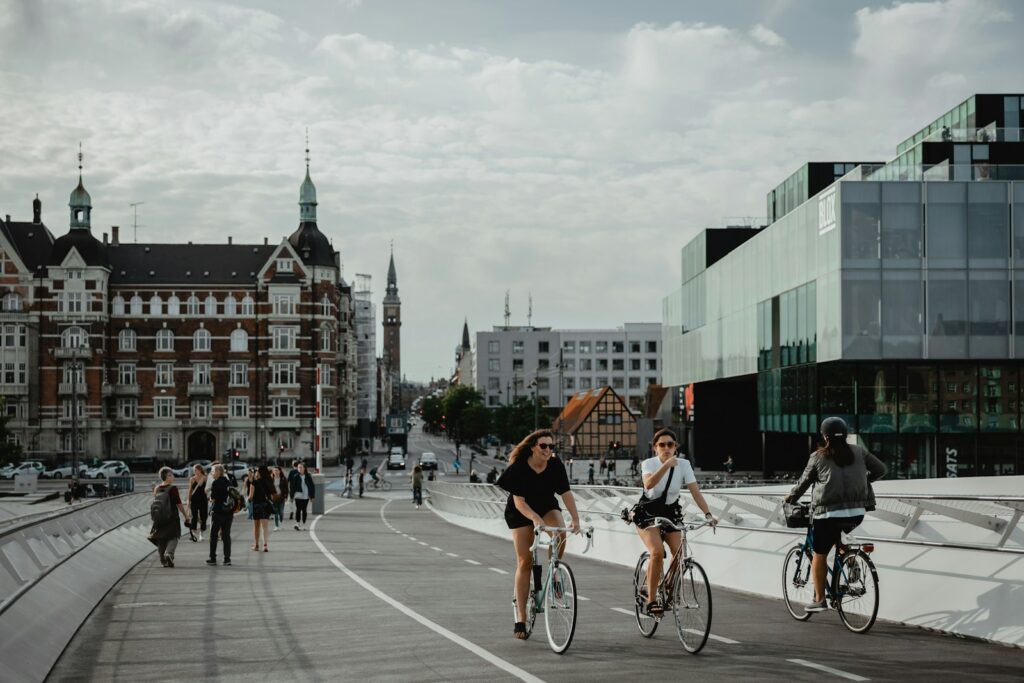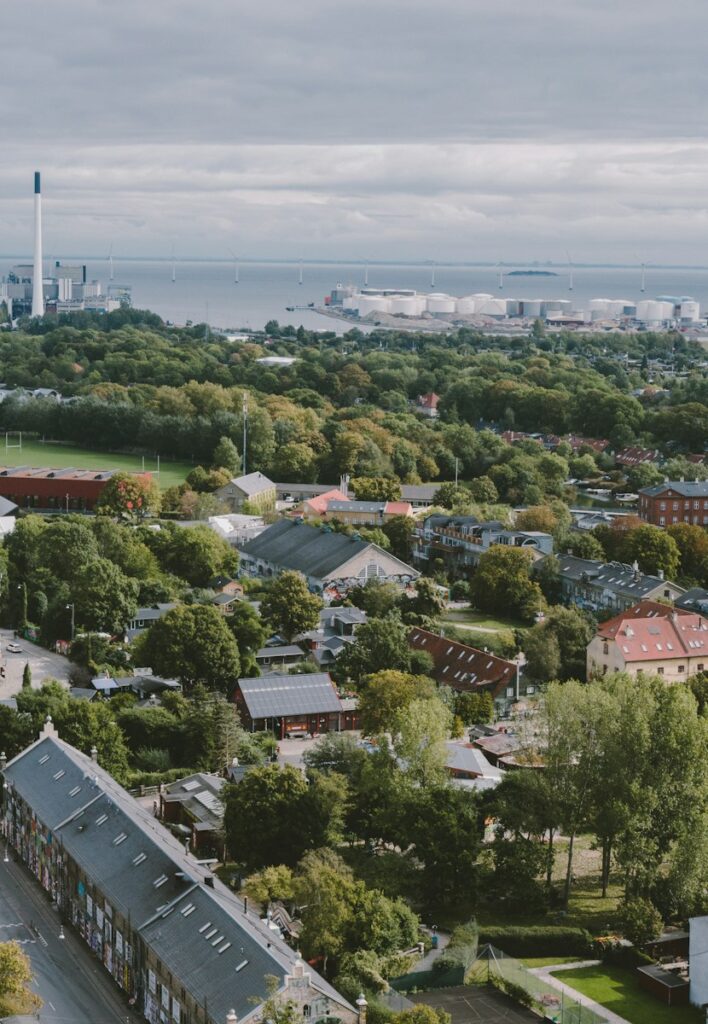The ultimate guide to relocating to Copenhagen in 2024
Coming up in this guide: banking, bureaucracy, finding fun, making friends, a whole load of cycling, and everything you need to know about moving to Copenhagen.
Denmark’s hyper-clean capital is currently having a bit of a boom:
During the past 20(ish) years, the percentage of non-natives in Copenhagen has leaped from 13.9% to 22.9%.
So… more people are moving to Copenhagen…
… and because you’re reading this article, you probably want to join them.
Good choice! It’s a lovely place to live, and big high points include great housing, top-quality transport and cyclability, high levels of English, some genuinely wacky neighborhoods, one of the planet’s best quality-of-life ratings, and world-class levels of safety and cleanliness.
So… to help you make the move, your buddies at Homelike have brought you everything you need to know about relocating to Copenhagen. We’ve covered perks, prices, learning the language, getting a job, making friends, finding a place to live (which can be surprisingly difficult), and plenty more.
Pack your suitcase and come join the party!
Why move to Copenhagen?
There are plenty of pros of moving to Copenhagen. They include:
- Highly-paid jobs: Denmark ranks 6th in the world for average salaries.
- It’s very clean and tidy: no matter where you’re relocating to Copenhagen from, your new home will probably be cleaner than your last one. Recycling is huge, the air is very clean, it’s possible to swim in the harbor(!), walking and cycling are very common, there’s a big focus on green policies and sustainable energy, and you won’t see much trash on the streets.
- Brilliant levels of English: you’ll never struggle to find an English speaker—in 2012, an estimated 86%(!) of Danish people spoke English. More than 10 years on, that figure’ll be higher… and levels of English are especially good in Copenhagen.
- High levels of safety: one of the biggest perks of relocating to Copenhagen for families—Denmark’s capital is one of the safest major cities in the world. You get little chance of terrorism, little chance of serious crime, no chance of any natural disasters, and very safe drivers and infrastructure.
- It’s perfect for cycling: in 2023, euronews.next voted Copenhagen as the 4th-best cycle-friendly city in the world. More on that later.
- Good inclusivity and tolerance: you’ll always feel welcome in Copenhagen. People are open and friendly, no matter who you are or where you’re from.
- Great quality of life: in 2023, Copenhagen ranked 4th on the planet for overall quality of life in this Mercer survey.
- Great public services: again, we’ll cover this in more detail soon. But you can expect world-class healthcare, education, and amenities.
… so, overall, it’s a great place to live! And it’s particularly good for people who want an organized, healthy, productive life.
To balance things out, we should probably include a few of the cons too (we don’t want you thinking we’re biased). Some of the negatives of moving to Copenhagen include…
… bad weather (even in the height of summer, average temperatures sit at only around 17°C/62°F), high property prices (including huge deposits!), a high cost of living, and some of the world’s highest taxes. And although you’ll find plenty of stuff to do, Copenhagen is noticeably less exciting than many other capital cities.
But, overall, we think the positives of moving to Copenhagen massively outweigh the negatives.

Visa requirements for moving to Copenhagen
If you’re moving to Copenhagen from another part of the EU/EEA area, you don’t need a visa. That said, you WILL need to get an EU residence document*, within 3 months of arriving in Denmark.
*note: if you’re from Finland, Iceland, Norway or Sweden, you *don’t* need to get an EU residence document.
If you’re not from the EU/EEA area, relocating to Copenhagen is much more difficult. Yep, some nationalities (like people from the US and the UK) can visit Denmark for up to 90 days with no visa. But if you want to stay longer, you’ll need to apply for a long-stay visa (there are different types of long-stay visas depending on your plans).
… if your visa is granted, you’ll automatically be given a temporary residence permit. Initially, this will usually allow you to stay in Denmark for one year (before you renew it).
Right now, Denmark doesn’t have a digital nomad visa… and has no plans to introduce one. None of the nation’s current visas are great for digital nomads, and it’s illegal to work in Denmark (even remotely) without having some type of work visa. So, yep: this means you shouldn’t even work remotely while on a 90-day visa-free stay (if you’re visiting from a nation that offers a 90-day visa-free stay). Here’s more information on your digital-nomadding options.
Another note: no matter where you’re moving from, you’ll also need to get a Civil Registration System (CPR) number. Every Danish resident has one—and you need it to get a job, pay tax, access your health insurance, and do other important daily-life things.
Best neighborhoods to live in Copenhagen
When you’re relocating to Copenhagen, you have many neighborhoods to choose from. Top picks include:
- Indre By (City Center): if you’re only relocating to Copenhagen for a few months or so, this is a great choice. Busy and bustling, it’s where you’ll find most of the city’s top tourist attractions (and lots of shopping streets). It’s also a great location for eating, drinking, partying and cafe-hopping.
- Nørrebro: because it’s the most multicultural part of the city, Nørrebro is a good choice for anyone moving to Copenhagen. Here, you’ll find (relatively) low-cost homes, food from around the planet, lots of kebab joints and thrift stores, and a good combo of centrality and affordability.
- Vesterbro: home to the Meatpacking District (currently the trendiest part of the city), Vesterbro is a gentrified spot home to cool coffee shops, cooler bars, and lots of underground nightlife venues. It’s a great choice for hipsters and young couples.
- Østerbro: the city’s greenest district, Østerbro offers parks, waterside stretches, lots of family-friendly fun, and many embassies and businesses. For all those reasons and more, it’s popular with families, jobseekers, and people who are planning to hang around long-term.
- Valby: another great choice for moving to Copenhagen long-term. Although it’s relatively close to the center, it’s a very residential district. With community vibes, lifelong locals and large family homes, it’s a great way to feel like you’re ‘really’ living in Denmark (without having to move to some tiny remote village). Expect an appealing mishmash of old and new, and very warm welcomes.
For much more detail, here’s our full guide to the 10 best neighborhoods in Copenhagen.
Finding accommodation in Copenhagen
The most well-known websites for finding accommodation in Copenhagen are boligportal.dk, lejebolig.dk, and Homelike (that’s us!). Another option is Facebook—if you hop on the platform, and search for terms such as ‘rentals Copenhagen’ and ‘apartments Copenhagen,’ you’ll find plenty of options.
But it’s not always so simple: finding accommodation in Copenhagen is one of the hardest parts of moving to Copenhagen. Prices are high, local landlords sometimes overcharge foreigners (so it’s often hard to know if you’re paying a fair price), and local people have an advantage (because they speak Danish!).
Another note on accommodation: many local landlords ask for huge sums of money in advance. Some require three months of rent upfront, along with ANOTHER three months of rent as a deposit. And on top of all that, many apartments come completely unfurnished (meaning newbies have to spend weeks finding furniture and appliances).
Average rent prices in Copenhagen currently sit at:
- 1-bedroom apartment in the city center: €1,642
- 1-bedroom apartment outside the city center: €1,200
- 3-bedroom apartment in the city center: €2,781
- 3-bedroom apartment outside the city center: €2,011
Instead of tolerating the tricky housing market, many Copenhagen newcomers decide to move into a serviced apartment or a serviced flat. All of ours are comfy, fully-furnished, ideal for living and working, and ready to move into today. And with us, you don’t need to negotiate with landlords, and you don’t need to endure any huge upfront payments.

Finding a job in Copenhagen
Average salaries in Copenhagen are some of the highest on the planet.
According to salaryexpert.com:
- The nation’s average annual salary sits at 463,238 kr (almost $68,000 USD)
- … and the hourly average rate sits at 222,71 kr (around $32 per hour)
The minimum adult wage per hour is 131.65 DKR (almost $20 per hour).
Some of Copenhagen’s biggest industries are education, health and transport. But because it’s a major capital city with a population of around 660,000, you’ll (of course) find jobs in every industry.
For finding a job after moving to Copenhagen, the best websites are jobindex.dk and jobnet.dk. If you exclusively want English-language jobs, workindenmark.dk is the best option. Other people use both LinkedIn and GlassDoor.
Warning: income tax in Denmark is very high. The top earners are taxed more than 52%, and ALL earners are taxed at a minimum of just over 12%.

Navigating bureaucracy in Copenhagen
After relocating to Copenhagen, you’ll have some boring bureaucracy to deal with (soz). Your four most important tasks will be:
Getting your residency
As we’ve already mentioned, if you’re from the EU/EEA area, you need to get an EU residence document (well, unless you’re from Finland, Iceland, Norway or Sweden). You do this by making an appointment with ‘SIRI’, an immigration-managing government organization.
If you’re from outside the EU, you need to get a visa. When you get that visa, you’ll automatically get a temporary residence permit.
Getting a CPR number
A CPR number is a ‘civil registration number.’
‘CPR’ stands for ‘Central Person Register,’ and everyone in Denmark has their own unique CPR number.
To get one, you need a permanent address (and some other documents, listed here). And you need this number to open a bank account, and see a doctor, and get your salary (etc etc).
You apply for this number by making an appointment at a Citizen Service Center.
Getting your tax number
Everyone in Denmark needs a tax card, and their own personal tax number.
You can apply for yours online. To do so, you usually already need to have a health insurance card, a CPR number, and a Danish address. Here’s more (including the portal for starting your application)
Opening a bank account
To open a bank account, you usually need photo ID, proof of address, your CPR number, and your mitID (an individualized personal digital-services key every person in Denmark needs to have*).
The most popular in-branch traditional-style banks are Danske Bank and Nykredit Bank.
… but the easiest option is to go with an online app (signups are faster, you don’t need to wait in any lines, and you can do it from home). The best online options are Wise, N26, and Lunar (which is a Danish bank). Important: even if you open an online account, you’ll still need the documents outlined above.
*yes, as you’ve noticed by now, Denmark loves bureaucracy.
Learning Danish
Okay, you don’t need to learn English for moving to Copenhagen (pretty much all young people speak English, and even lots of older folks have an excellent grasp of the language).
(and if you’ll only be sticking around a short while, there’s really no need).
… but if you’ll be living long-term in Copenhagen, you should learn Danish. Local people will appreciate it, bureaucracy will become easier, you’ll be able to communicate with EVERYONE, and you’ll have a better time at local markets. And most importantly, you’ll better understand people, culture, and everyday life.
To get started, your best option is Duolingo—it’s a great way to learn the basics, and the app is basically just a big fun game. When you want to get a bit more serious, Babbel, Memrise and Preply are good options. Preply is particularly good for finding face-to-face online lessons.
Many Copenhagen newcomers take in-person classes at some of the city’s language schools. We recommend Berlitz and Studieskolen.
Copenhagen’s culture and people
After relocating to Copenhagen, you’ll find people:
- Work hard
- Dress smart
- Are very open-minded and welcoming
- Like art, cycling, and independent stores and venues
- Are very progressive and world-aware: they value being respectful and eco-friendly
- Are kind, friendly, and helpful (though they can seem reserved on a superficial level)
(quick note: obviously, everyone is different. So this is just a vague generalization. But you asked for it)
Some social etiquette things to be aware of:
- People aren’t tactile, like many western Europeans…
- … so shaking hands is preferred to kissing or hugging
- Tipping isn’t expected; bills usually include a service charge
- People are super punctual and respectful of each other’s time (even socially)
- It’s expected to be mindful of other people at all times: don’t be super-loud in public, let others off transport before you get onto transport, and don’t skip lines
Healthcare in Copenhagen
In Numbeo’s 2023 mid-year healthcare survey, Denmark ranked 6th in the world. And it routinely performs equally-well on similar lists.
Denmark has top-class public healthcare, and all citizens and residents (whether native or non-native) are entitled to care. You receive this entitlement by first obtaining your CPR number—and after obtaining this number, you receive a Sundhedskort (‘The Yellow Card’).
Although most treatments are free, you need to pay for some services (medicine, dental care, some psychological and specialist treatments). The healthcare system is very efficient, waiting times are usually quite short, and many medical professionals have excellent levels of English.
Some Danish employers offer private healthcare as part of their salary package, but only a small portion of Danish people have their own private healthcare. That said, private treatment offers shorter waiting times, more specialized treatment, and a higher quality of care.
… so if you do want to get private insurance, Bupa is a good place to start.
Overall, moving to Copenhagen is a good choice if you want easy access to world-class healthcare.
Quality of life in Copenhagen
As we’ve already vaguely covered, Copenhagen’s quality of life is excellent.
But here’s a bit more detail:
- A good work-life balance is core to life: the majority of office workers finish before 5pm, employers are respectful of employees’ time, people aren’t expected or encouraged to work time they’re not paid for, and everyone gets five weeks’ paid vacation per year. For work-life balance, this is one of the best places on the planet.
- Lots of activities and events: you’ll find loads of music and arts festivals, lots of food and drink festivals, a load of exercise events (including boating, biking, and running), and over 50 galleries and museums. Some of the most famous festivals include Distortion, CopenHell, and Copenhagen Jazz Festival—while odder events include sailing, car parks, e-sports, and the biggest documentary film festival in Scandinavia. For things to do, Copenhagen is without doubt the best place in Denmark.
- Clean air: the city recently ranked #2 in Europe for air quality. And because of developments in energy and transport, the air quality is only getting better.
- A big focus on the outdoors: as we’ve mentioned, the city is home to events and festivals involving a whole load of sports. Daily cycling and walking are very popular, while many people go boating and fishing in the city. And as a nice bonus, it’s also easy to reach forests, lakes and fjords from Copenhagen (and often by public transport!).
- … and on top of all that, the nation is VERY safe, clean, and tidy.
Education in Copenhagen
If you’re moving to Copenhagen with kids, good news: there are 16 great international schools in the city. Three of the best are Prince Henrik School, European School Copenhagen, and Montessori International Preschool.
… you’ll also find many non-international schools, along with excellent education for all ages. In the 2023 Best Countries Report, Denmark came 10th in the world for education.
Denmark’s universities are even better than its schools: in 2019, the nation was ranked as having the fifth-best higher education system in the world. We’ve covered this in more detail a little later.
And as we mentioned, you’ll also find many language schools in the city: ideal if you want to learn Danish! We recommend Berlitz and Studieskolen.

Transportation in Copenhagen
Copenhagen’s public transport is excellent.
It’s made up of:
- Metros (four lines, and all operating 24/7)
- Trains (many of which run every 4 minutes)
- Buses (sometimes running every 3 minutes during rush hour)
- … and ‘harbor buses’ (which are really just boats, and serve 9 different stops along the harbor)
When relocating to Copenhagen, MANY people choose not to buy a car. And it’s absolutely possible to get around the city (and beyond) without one.
That said, driving in Denmark is easy: people drive safely, roads are well-maintained, signposting is great, and other drivers are courteous. Cons include: parking in Copenhagen is limited and expensive, there are many one-way systems in the city… and during rush-hour traffic, it’s definitely faster to use public transport within Copenhagen.
As we’ve mentioned, Copenhagen is one of the world’s best cities for cycling. You get 546 km (340 miles) of bike-friendly paths, 70% of Danish people own a bicycle, almost 50% of Copenhagen’s residents use a bicycle every day, and drivers and pedestrians are hyper-courteous.
Copenhagen is also a very pedestrian-friendly place. You’ll find many sidewalks, lots of pedestrian crosses, and very organized (and clean) streets.
Cost of living in Copenhagen
After moving to Copenhagen, here are the prices you can expect:
- One-way ticket on local public transport: €3.22
- Regular monthly pass for local public transport: €80
- Meal for 1 at an inexpensive restaurant: €20
- 3-course meal for 2 people at a mid-range restaurant: €107
- Large draught domestic beer in a bar or restaurant: €8
- Regular cappuccino in a cafe or restaurant: €5.95
- Regular liter of milk from a supermarket: €1.84
- 12 regular eggs from a supermarket: €4.49
- 1kg of local cheese from a supermarket: €11.92
- 1kg of chicken breast filets from a supermarket: €10.53
Note: we’ve covered rental prices already, in the ‘finding accommodation’ section above.
Note 2: we’ve taken all these figures from Numbeo, great for finding up-to-date cost-of-living stats (for moving to Copenhagen, or anywhere else).
Moving to Copenhagen from the UK
Compared to the UK:
- Copenhagen is more expensive (unless you’ve been living in London)
- Supermarkets have a smaller range of produce
- You won’t find as many indoor things to do
- People are a little more glamorous
- You won’t find as much nightlife
- It’s less multicultural
- Copenhagen is safer
Again, if you’re moving to Copenhagen from the UK, you will need a visa (for stays longer than 90 days).
Moving to Copenhagen from the US
How’s here Copenhagen’s culture compares to US culture:
- People can seem cold and aloof (though they’re actually very friendly)
- It can be tough to make friends if you’re only around for a short while
- There’s a smaller range of products in supermarkets
- Public transport is way better
- Food can seem a little bland
- Winters can be very dark
- People like to follow rules
- There’s no tipping culture
And, again, for stays of longer than 90 days, you’ll need a visa.
Moving to Copenhagen as a young adult
Moving to Copenhagen as a young adult is a good choice if you value good employment opportunities, high salaries, and good education.
The city’s two best universities are the University of Copenhagen and the Technical University of Denmark, both of which ranked in the top 104 in the 2023 QS World University Rankings. That said, the city is home to many other universities (some of them specializing in arts and business)… and many of their courses are taught in English.
But… moving to Copenhagen as a young adult isn’t the best choice if you prioritize fun over productivity. If you want to spend your weekends drinking, dancing and making friends, there are better places to live.
If you want to find a good job, you usually need to learn Danish. But even if you get a lower-paid job in a bar or cafe, you’ll still make reasonable money: as we already covered, the minimum adult wage is 131.65 DKR per hour (almost $20 per hour).
… and because the Danish unemployment rate sits at only around 4%, it’s clear most people are able to find a job (no matter their age).
Moving to Copenhagen with a family
Relocating to Copenhagen is a 10/10 choice for family-conscious people.
Schools are great, the city is clean and safe, most people speak English (so it’ll be easy for your kids to communicate), healthcare is excellent, people are very family-oriented…
… and you’ll find lots of playgrounds, child-friendly attractions, and family-friendly restaurants.
In Copenhagen, you’ll often see young groups of kids playing without too much adult supervision… which tells you how safe and kid-friendly the city is.
And because people often base their lives around their young families, it’s pretty easy to make friends with other parents.
Some of the city’s best family-friendly districts are: Frederiksberg (with upscale homes, lots of international schools, and all the amenities you could ever need), Østerbro (with lots of green spaces and job opportunities), and Valby (where you’ll find affordable family homes, and an old-school community atmosphere).
Moving to Copenhagen: final thoughts
Okay, that’s us done—that’s everything you need to know about moving to Copenhagen!
As you’ve (hopefully!) learned by now—it’s a lovely place to live. And it’s especially good for families, older couples, and people who value high levels of safety.
But, it’s not all good news: as we mentioned, one of the toughest parts of relocating to Copenhagen is usually finding a place to live. Locals take the best places (and the best prices), landlords often over-charge foreigners, and many places come unfurnished. So, many newcomers (especially in the short-term) move into serviced apartments or serviced flats.
All of our apartments are ready to move into today—and they’re all comfortable, fairly-priced, completely furnished, and perfect for living and working. A nice way to make things fast and simple!
Anyway, no matter where you live in Copenhagen, we massively recommend moving to the place. It’s clean, it’s safe, it’s cycle-friendly, and you get high wages, world-class amenities, and an excellent quality of life.
Thanks for reading, thanks for choosing Homelike, and enjoy Copenhagen!






















